Range Rover Evoque: Anti-Theft - Active
Anti-Theft - Active - Component Location
COMPONENT LOCATION
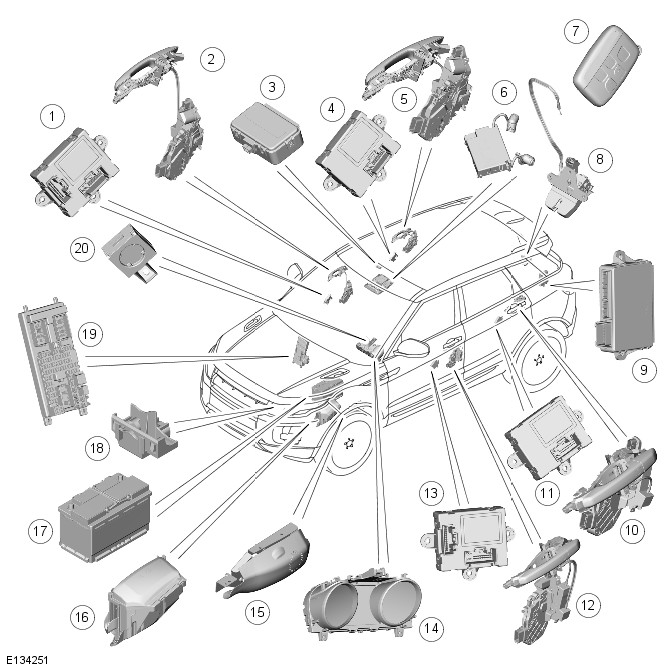
- RH (right-hand) front door module
- RH front door latch mechanism
- Radio Frequency (RF) receiver
- RH rear door module
- RH rear door latch mechanism
- Interior motion sensor
- Remote handset
- Liftgate latch mechanism
- Keyless Vehicle Module (KVM)
- LH (left-hand) rear door latch mechanism
- LH rear door module
- LH front door latch mechanism
- LH front door module
- Instrument cluster - Alarm LED (light emitting diode)
- Security sounder (Integrated Battery Backed Sounder in certain markets)
- BJB (battery junction box)
- Battery
- Bonnet switch
- CJB (central junction box)
- Immobilizer Antenna Unit (IAU)
Anti-Theft - Active - Overview
OVERVIEW
The active anti-theft system monitors the hinged panels for unauthorized opening. In some markets the anti-theft system also incorporates monitoring of the vehicle interior and vehicle tilt sensing.
The active anti-theft alarm system is controlled by the following body system control modules:
- CJB (central junction box)
- LH (left-hand) and RH (right-hand) front and rear door modules
- Instrument cluster.
The CJB is the main controller in the system. The CJB controls the following security functions, in addition to other vehicle functions:
- Locking, double locking and unlocking
- Monitoring of hinged panel micro switches and panel ajar states
- Interior motion sensor
- Battery backed sounder or vehicle horns
- Passive arming and disarming
- Panic alarm function
- Remote handset transponder reading
- Interior lighting.
Two levels of vehicle anti-theft alarm are available; perimeter mode monitors all opening panels and volumetric mode (if fitted) monitors the vehicle interior for intrusion and it also incorporates a tilt sensor to monitor if the vehicle is being moved.
NOTE: Volumetric mode and tilt sensing are not available in certain markets.
The remote handset provides the following functionality:
- Unlock (central unlock or single point entry)
- Lock and double lock
- Liftgate release
- Approach lighting
- Panic alarm.
The lock and unlock buttons also control a 'lazy' lock and unlock feature which will automatically close or open the windows with an extended press of the applicable button. This feature is only available in certain markets and is controlled in conjunction with the door modules.
WARNING: Never double lock the vehicle with any person or animal inside.
NOTE: Double locking is only available in certain markets.
The remote handset contains an emergency access key. This can be used in the event of failure of the remote handset or the vehicle battery to unlock the vehicle. The LH door handle contains a concealed mechanical key barrel which can be used with the emergency key to access the vehicle. This will not disable the perimeter or interior alarm systems which will be activated when the door is opened. To cancel the alarm, the remote handset must be held next to the Immobilizer Antenna Unit (IAU) and the stop/start button must be pressed.
Refer to: Handles, Locks, Latches and Entry Systems (501-14 Handles, Locks, Latches and Entry Systems, Description and Operation).
Anti-Theft - Active - System Operation and Component Description
Control Diagram
NOTE: A = Hardwired; F = RF Transmission; N = Medium Speed CAN (controller area network) bus; O = LIN (local interconnect network) bus
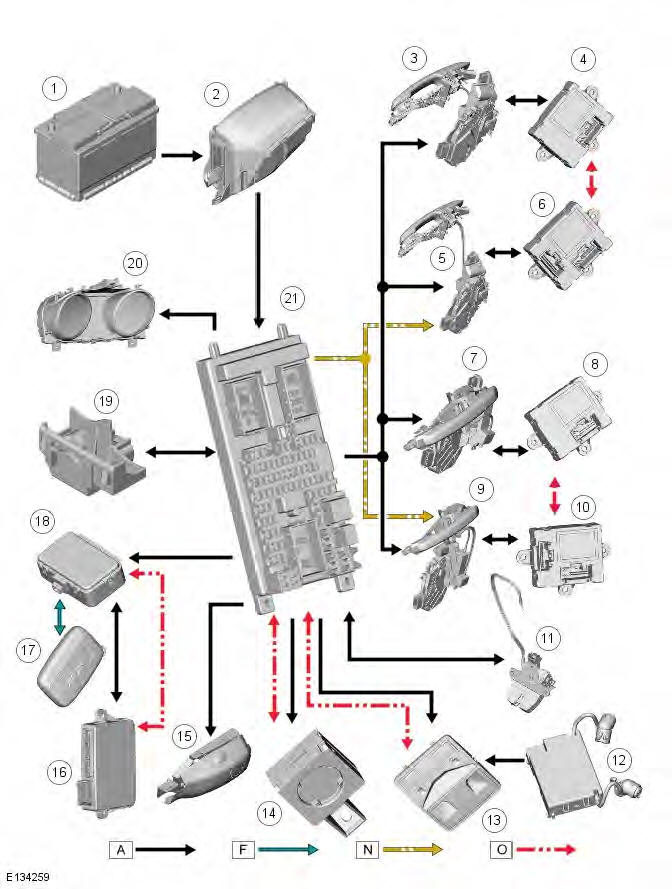
- Battery
- BJB (battery junction box)
- RH (right-hand) rear door latch mechanism
- RH rear door module
- RH front door latch mechanism
- RH front door module
- LH (left-hand) rear door latch mechanism
- LH rear door module
- LH front door latch mechanism
- LH front door module
- Liftgate latch mechanism
- Interior motion sensor
- Front overhead console
- Immobilizer Antenna Unit (IAU)
- Security sounder (Integrated Battery Backed Sounder in certain markets)
- Keyless Vehicle Module (KVM)
- Remote handset
- Radio Frequency (RF) receiver
- Bonnet switch
- Instrument cluster - Alarm LED (light emitting diode)
- CJB (central junction box)
System Operation
PRINCIPLES OF OPERATION
The CJB automatically arms and disarms the active anti-theft system when it operates the Central Locking System (CLS).
On vehicles without an intrusion detection module, only the perimeter mode is available to monitor the hinged panels and the validity of the remote handset.
When perimeter mode is active, the CJB monitors panel ajar switches located in the latch mechanisms of the front and rear doors and the tailgate. A separate hood ajar micro switch, located in RH hood latch mechanism in the engine compartment, monitors the hood status.
When volumetric mode is active, the CJB monitors the interior of the vehicle for movement using an intrusion detection module located in the front overhead console.
Arming
On vehicles without an intrusion detection module and a tilt sensor, the active anti-theft system is armed in the perimeter mode when the vehicle is either locked or double locked.
On vehicles fitted with an intrusion detection module, the system has 2 modes of operation; perimeter mode and volumetric mode.
Perimeter mode
Perimeter mode only monitors the hinged panels and validity of the remote handset in the start control module. Perimeter mode is activated by a single press of the lock button on the remote handset.
Volumetric Mode
Volumetric mode monitors the vehicle interior for intrusion. If the vehicle is fitted with a battery backed sounder, which incorporates a tilt sensor, the vehicle attitude is also monitored when volumetric mode is active. Volumetric mode is activated by a second press of the lock button on the remote handset. The second press of the button must occur within 3 seconds of the first press. The second press of the lock button also activates the perimeter mode double locking feature.
The CJB arms the active anti-theft system when it locks or double locks the vehicle, providing all the following conditions are met:
- all doors, tailgate and hood are closed
- the CJB is not in transit mode.
When the vehicle has successfully completed its locking routine, confirmation will be given by a single flash of the turn signal indicators to indicate the locked condition. If double locking is activated, then the confirmation will be given by a double flash of the turn signal indicators; one flash for locked and one long flash for double locked.
Mislock
If any doors, liftgate or hood is open when a lock or double lock request is received, the active anti-theft alarm system remains disarmed and the CJB generates a short mislock sound from the vehicle horns or battery backed sounder and the turn signal indicators will not flash. Each attempt to lock will be confirmed by an audible chime being emitted.
When the CJB arms the active anti-theft system, it first enables perimeter mode and monitors the status of the hinged panels. If the vehicle is fitted with a battery backed sounder, an arming signal is sent from the CJB to enable the sounder.
If the vehicle is double locked and fitted with an intrusion detection module, the CJB then sends an arming signal to the module and the tilt sensor when double locked. The CJB ignores the signals from the intrusion detection module for the first 30 seconds to allow time for the vehicle interior to settle and prevent false alarm activation.
If the liftgate is opened via the remote handset, the intrusion detection module and the tilt sensor are inhibited until the liftgate is closed.
Disarming
The CJB will disarm the active anti-theft system to prevent false alarm activation under certain conditions as follows:
- When the active anti-theft system is armed in volumetric mode, if the vehicle battery voltage decreases to less than 9 volts, the CJB will disable the volumetric mode and remain in perimeter mode only. This prevents false alarm activation because the intrusion detection module cannot operate correctly below 9 volts.
- On vehicles fitted with a battery backed sounder, if the vehicle battery voltage decreases from 9.5 to 9 volts in more than a 30 minute period, the CJB de-activates the battery backed sounder and, if required, will use the vehicle horns to sound an audible alarm trigger warning. This prevents false alarm activation. At voltages below 9 volts, the CJB will not generate the 'heartbeat' signal to the battery backed sounder. The battery backed sounder interprets this as the CJB has been tampered with and activates its sounder. If the battery voltage subsequently rises to more than 9.5 volts, the CJB will re-arm the battery backed sounder.
- If the vehicle is unlocked using the unlock button on the remote handset and, within 60 seconds a hinged panel is not opened, the CJB automatically re-locks the vehicle and re-arms the active anti-theft system (if the 'auto re-lock' feature is enabled). This prevents leaving the vehicle unlocked and disarmed by accidental operation of the remote handset unlock button.
Alarm
When the alarm is triggered, the CJB activates audible and visual warnings. The audible warnings are produced by the security horns or the battery backed sounder. Visible indications are produced using the turn signal indicators.
The CJB activates the vehicle horns or battery backed sounder and the visual indications for 30 seconds. The activation is stopped for 5 seconds and, if the alarm trigger is still present, the CJB will cycle again for 30 seconds (60 seconds in certain markets). This will be repeated for up to a maximum of 10 cycles (3 cycles in certain markets) of 30 seconds (60 seconds in certain markets) for any one arming period. The CJB will ignore the trigger cause if the 10 cycles (3 cycles in certain markets) have been completed and the alarm trigger is still present or until it receives a disarm signal.
NOTE: If the battery backed sounder is triggered due to tamper detection, the visual indication using the turn signal indicators is not activated.
The alarm can be triggered by any of the hinged panels being opened, the interior motion sensor detects a movement inside the vehicle, the tilt sensor detects vehicle movement or an ignition tamper is detected (invalid remote handset).
Battery Backed Sounder
When the CJB arms the active anti-theft system, in either the perimeter mode or the volumetric mode, the CJB sends an arming signal to the battery backed sounder on the LIN bus. When the system is armed in the volumetric mode, the CJB also sends an arming signal to the tilt sensor (if fitted).
NOTE: If a battery backed sounder is fitted, it is also armed with the perimeter mode lock request. However, the tilt functionality is not enabled in perimeter mode.
On receipt of the arming signals, the sounder and the tilt sensor respond with a status message. If the CJB does not receive the status signals within 12 seconds, the CJB assumes there is a fault and responds with a disarm signal to either the sounder and/or the tilt sensor and stores a related fault code. If the sounder is disarmed when the active anti-theft system is armed and the system is subsequently triggered, the CJB energizes the horn relay and uses the vehicle horns to sound the audible warning in place of the sounder.
When the sounder is armed, the CJB sends a periodic (heartbeat) signal to the sounder which prompts the sounder to monitor the vehicle battery supply and the LIN bus link with the CJB. The sounder will operate if:
- it receives an alarm signal from the CJB or the tilt sensor
- the power supply or the LIN bus link to the CJB is disrupted.
The tilt sensor measures the longitudinal and lateral angle of the vehicle over a range of +-16 degrees from the horizontal.
When the active anti-theft system is armed in volumetric mode, the tilt sensor stores the current vehicle angles in its memory and monitors the tilt sensor readings. If the vehicle angle changes in either direction by more than the alarm limit, the tilt sensor activates the sounder.
If the alarm system is active and the battery or the battery backed sounder is disconnected, the sounder will operate without the visual indication of the turn signal indicators flashing.
Global Open/Close
The global open/close feature allows the user to fully raise/lower the windows with a single press of a remote handset button. The button must be pressed and held for more than 2 seconds. Either or both global open/close functions can be disabled using a Land Rover approved diagnostic system.
NOTE: Remote global close is not available in certain markets, North American Specification (NAS) for example.
Single Point Entry
The single point entry feature only unlocks the driver's door, all other doors remain locked. A single press of the unlock button on the remote handset will unlock only the driver's door, a second press is required to unlock the remaining doors and liftgate.
If the vehicle is double locked, the first press of the unlock button on the remote handset unlocks the driver's door. The remaining doors revert to the single locked state and can therefore be unlocked using the interior door handles, the remote handset unlock button or the unlock switch on the instrument panel switch pack.
Changing from central locking to single point entry can be carried out by pressing the lock and unlock buttons on the remote handset simultaneously. The turn signal indicators will flash to confirm that the function change has been performed.
Drive Away Locking
The drive away door locking feature locks the doors and the liftgate if they are unlocked when the vehicle reaches a certain speed.
On vehicles with automatic transmission, with all the doors, liftgate and hood closed and the gear selector not in 'P' Park or 'N' Neutral position, if the CJB detects, via a high speed CAN message from the ABS (anti-lock brake system) module, that the vehicle speed is more than 7 km/h (5 mph), the doors will automatically lock.
On vehicles with manual transmission, with all the doors, liftgate and bonnet closed, if the CJB detects, via a high speed CJB message from the ABS module, that the vehicle speed is more than 7 km/h (5 mph), the doors will automatically lock.
Remote Handset Additional Features
In addition to the lock and unlock buttons, the remote handset has convenience buttons.
Panic Alarm
The panic alarm feature allows the user to activate the vehicle alarm system using the remote handset. The 'panic button', identified by a triangle symbol, can be pressed 3 times within 3 seconds or pressed and held for more than 3 seconds to activate the panic alarm.
The panic alarm feature can be cancelled after 5 seconds of operation by pressing the triangle symbol 3 times within 3 seconds or pressing and holding for more than 3 seconds.
Global Open/Close
A global open and close feature can be operated from the remote handset. This feature allows the vehicle windows to be opened/closed by a single press of the lock or unlock button. The button must be pressed and held for more than 2 seconds to activate the global open/close feature. The global open/close feature is not available in all markets. The windows must be initialized for the global functionality to work.
Liftgate Release
A liftgate release button can pressed to unlock and release the liftgate latch only. This will operate with the vehicle locked and alarmed or unlocked. If the vehicle is locked and alarmed, when the liftgate release button is pressed, the liftgate can be opened without triggering the alarm system. When the liftgate is subsequently closed, the alarm will be re-activated.
Headlamp Convenience
A headlamp convenience button can be pressed to operate the headlamps to assist departure or approach to the vehicle. A single press of the button will operate the headlamps for approximately 25 seconds, after which time they will automatically turn off. A second press of the button will turn off the headlamps if the 25 second period has not been reached. Pressing the stop/start button within the 25 second period will also turn off the headlamp convenience feature.
Convenience mode
When the vehicle is unlocked using the unlock button on the remote handset, the vehicle's electrical system initiates convenience mode. The following systems become active:
- memory - seat adjustment and mirror position
- interior and exterior lighting
- audio system
- instrument cluster message center
- horn
Component Description
DOOR MODULES
The door modules provide the interface between the door latch motors, the door and latch switches and the CJB. The door modules provide door micro switch status information and enable the door motors on request from the CJB.
The rear door modules are controlled via the front door modules on the LIN bus. Additionally, the front door modules also control the exterior mirror functions.
CENTRAL JUNCTION BOX
The CJB controls the following functions:
- the horns
- the liftgate latch motor and micro switches (including the liftgate external release switch)
- the liftgate ajar switch
- the turn signal indicators
- the fuel filler flap operation.
The CJB also has a connection to the RCM (restraints control module) for automatic operation of the interior lights and the turn signal indicators in the event of an accident.
NOTE: If the CJB is replaced, the new module will require configuring to the master car configuration using a Land Rover approved diagnostic system.
The CJB automatically arms and disarms the active anti-theft system when the vehicle is locked and unlocked after successful confirmation that a valid remote handset has been used.
INSTRUMENT CLUSTER
The instrument cluster controls the alarm indicator which is incorporated in the main display in the instrument cluster.
The instrument cluster also controls, in conjunction with the CJB, the ECM (engine control module) and the ABS module, the engine immobilization. The ECM controls the engine crank and fuel functions and the ABS module controls the tilt function. The ECM and ABS module communicate to each other after the CJB processes the valid remote handset information.
Alarm Indicator
The alarm indicator is a LED located in the instrument cluster. When the ignition is off, the indicator gives a visual indication of the active anti-theft system to show if the alarm system is set or unset.
When the ignition is on, the indicator provides a visual indication of the status of the passive anti-theft (engine immobilization) system. If the immobilization system is operating correctly, the LED will be illuminated for 3 seconds at ignition on and then extinguish.
If a fault exists in the immobilization system, the LED will be either permanently illuminated or flashing for 60 seconds.
This indicates that a fault exists and a fault code has been recorded. After the 60 second period, the LED will flash at different frequencies which indicate the nature of the fault.
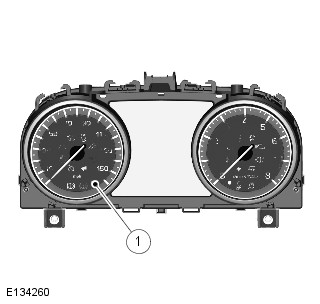
- Alarm indicator
Operation of the alarm indicator is controlled by the instrument cluster which varies the flash rate of the LED to indicate the system status of the alarm and the immobilization systems.

VEHICLE HORNS
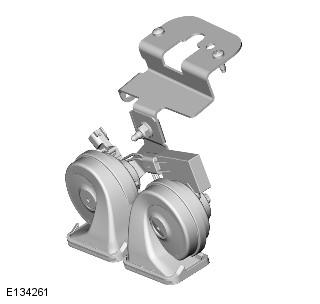
The vehicle horns are located above the front bumper armature. The horns are connected directly to the CJB which activates the horns when the alarm is triggered.
BATTERY BACKED SOUNDER (if fitted)
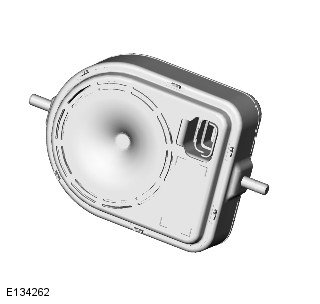
The battery backed sounder is located in the LH wheel arch. The sounder is only fitted in certain markets.
On vehicles with a battery backed sounder, a tilt sensor is incorporated which monitors the vehicle attitude. The CJB monitors the tilt sensor and can detect if the vehicle is being moved, towed or raised and activate the alarm.
Operation of the sounder is controlled by the CJB on a LIN bus. The sounder is also connected with a permanent battery supply via the CJB. An integral, rechargeable battery powers the sounder if the vehicle battery supply from the CJB is interrupted.
INTERIOR MOTION SENSOR
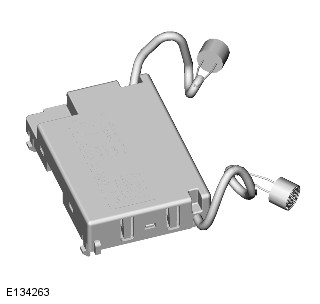
The intrusion detection module is an optional fitment in some markets and is not available in other markets. The intrusion detection module comprises two sensors which allow the interior of the vehicle to be monitored. The module is located in a central position in the front overhead console.
The intrusion detection modules are activated with the volumetric mode which in turn is enabled when the vehicle is double locked. The vehicle can be locked and alarmed with the module deactivated if a pet is to be left in the vehicle for example, by single locking the active anti-theft system.
When volumetric mode is active, if the vehicle battery voltage falls to below 9 volts, the CJB will ignore any inputs from the module to prevent false alarm activation.
Anti-Theft - Active
Torque Specifications

Anti-Theft Alarm Horn with Integral Battery
Removal
NOTE: Removal steps in this procedure may contain installation details.
1. WARNING: Make sure to support the vehicle with axle stands. Raise and support the vehicle.
2. Refer to: Fender Splash Shield (501-02 Front End Body Panels, Removal and Installation).
3. Torque: 7 Nm
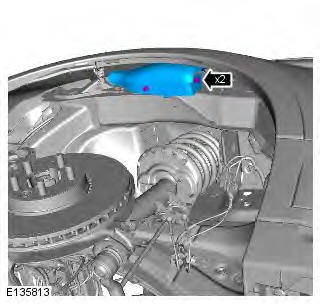
4. Torque: 7 Nm
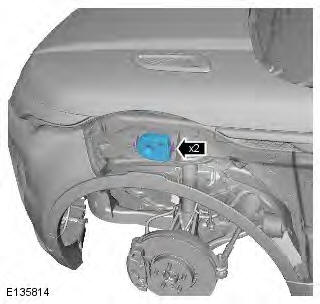
5.
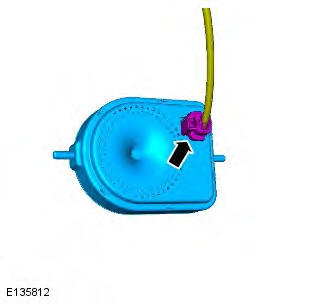
Installation
1. To install, reverse the removal procedure.
Hood Switch
Removal
NOTE: Removal steps in this procedure may contain installation details.
1.
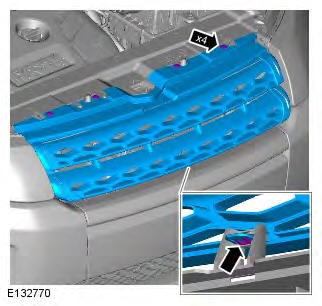
2. Torque: 5 Nm
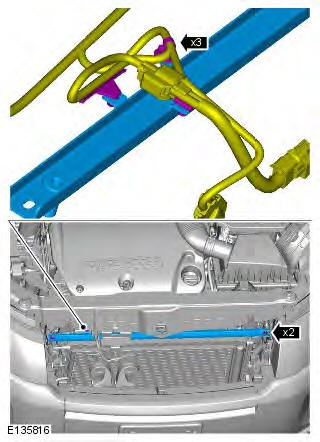
3. CAUTION: Make sure that the clips are correctly located.
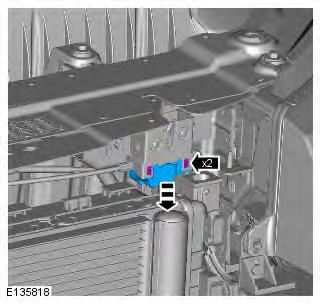
4.
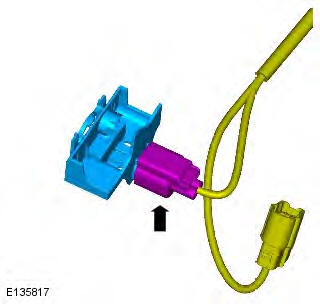
Installation
1. CAUTION: Make sure that the hood latch switch is correctly located. To install, reverse the removal procedure.
Anti-Theft - Active
Principles of Operation
Electric Steering Column Lock (ESCL)
For a detailed description of the anti-theft - active operation, refer to the relevant Description and Operation section of the workshop manual. REFER to: (419-01A Anti-Theft - Active)
Inspection and Verification
CAUTION: Diagnosis by substitution from a donor vehicle is NOT acceptable. Substitution of control modules does not guarantee confirmation of a fault, and may also cause additional faults in the vehicle being tested and/or the donor vehicle.
1. Verify the customer concern.
2. Visually inspect for obvious signs of damage and system integrity.
Visual Inspection

3. If an obvious cause for an observed or reported concern is found, correct the cause (if possible) before proceeding to the next step.
4. If the cause is not visually evident check the system for any logged Diagnostic Trouble Codes (DTCs) and proceed to the DTC Index.
DTC Index
For a complete list of all Diagnostic Trouble Codes (DTCs) that could be logged on this vehicle, please refer to Section 100-00.
REFER to: Diagnostic Trouble Code (DTC) Index - DTC: Electric Steering Column Lock Module (ESCL) (100-00 General Information, Description and Operation).

